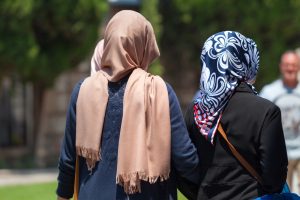In this editorial, we feature guidance from His Holiness, the Worldwide Head of the Ahmadiyya Muslim Community, on the wearing of the hijab (head covering) in UK primary schools.

What Muslim women wear on their heads has become the subject of fierce controversy over the past several years. While the wearing of the niqab, or face veil, in public places has been banned in several European countries, the hijab, or head covering has now come under scrutiny. In November last year, Ofsted, the UK’s Office for Standards in Education, Children’s Services and Skills, which oversees educational issues, issued a recommendation to its school inspectors in the UK to question young Muslim primary school girls wearing a hijab or similar headscarf. The Head of Ofsted and chief inspector of schools said:
‘In line with our current practice in terms of assessing whether the school promotes equality for their children, inspectors will talk to girls who wear such garments to ascertain why they do so in the school.’
Some Muslim organisations reacted with anger, claiming that Ofsted were being racist and Muslim girls were being denied a basic religious right. Further, a letter signed by over a 1000 teachers, academics and faith leaders stated that it was ‘a kneejerk, discriminatory and institutionally racist response that will violate civil liberties and create a climate of fear and mistrust in schools.’ Many others, however, supported the decision and saw the wearing of the hijab by girls of a young age as a symbol of oppression and even radicalisation.
This year, a top London primary school decided to ban children under eight from wearing the hijab during the school day. After sustained criticism and a petition signed by more than 19,000 people calling for the ban to be lifted, the school reversed its decision, leading to outcry from both sides of the debate. In an ironic twist of events, the Head teacher involved now says that her words were taken out of context by the media who misrepresented her statement about young girls wearing the hijab.
So what is the balance here? Was Ofsted right to question young Muslim girls on their choice of head covering? Or should very young Muslim girls be defended in their choice to wear the hijab?
As members of the Ahmadiyya Muslim Community, we look to guidance from His Holiness, Hazrat Mirza Masroor Ahmadaba, Worldwide Head of the Ahmadiyya Muslim Community, Fifth Successor to the Promised Messiahas. The Review of Religions has regularly featured the responses of His Holiness on controversial topics such as mass immigration into Europe, the causes of terrorism and radicalisation and the true meanings of jihad. Regular readers will have noted some recurrent features of these responses of His Holiness – whilst they are perfectly balanced, tolerant and progressive, they remain exclusively based on the true teachings of Islam. Solutions offered by His Holiness therefore embody reason and moderation. Indeed, as the Khalifah (Caliph – Successor) of the Promised Messiah, Hazrat Mirza Ghulam Ahmadas, His Holiness continues to guide us towards the authentic teachings of Islam in all matters.
And so returning to the case of the primary school hijab controversy, we find the same aforementioned characteristics in the latest guidance issued by His Holiness on this topic, being published here in The Review of Religions. His Holiness has given a very practical, wise and fair response to the subject based on Islamic teachings. His Holiness has explained while Islam does require that young women wear the hijab after adolescence, it does not ask prepubescent girls to don the headscarf. His Holiness said:
‘Islam does not require young girls to wear headscarves. Only when they reach an age of full physical maturity is it required and this is generally in teenage years. Thus there is no Islamic requirement for any primary aged girl to wear a headscarf.’
That said however, His Holiness does point out that ultimately, wearing the hijab is a personal choice for young girls:
‘If a young primary aged Muslim girl wears a headscarf freely and out of her own desire after seeing her mother or elder relatives wear them then this is something that is a personal matter and nothing wrong with it. If a girl is naturally inspired by her mother then this is something positive. Young children girls and boys, often imitate their parents, which is a natural part of growing up.’
Moreover, His Holiness raises concern over the potential impact of questioning very young school girls, saying:
‘In terms of questioning schoolgirls why they wear a hijab – it cannot be right to ask very young girls who are aged just 4 or 5 or in early years such questions. This could easily confuse them, cause stress and even lead to mental health issues later in life. Children need to be valued for who they are, regardless of race or religion. When young children’s choices are questioned by adults, it can make them feel as if they have done something wrong.’


a katz | Shutterstock
All members of all religious dominations should be afforded equal respect. Young boys from Sikh communities often wear their turbans to school, and at times young Jewish school boys wear the kippah. To single out young Muslim girls wearing the hijab would therefore be discriminatory. All religious symbols should be treated equally and no one religion should be targeted as this can make its followers feel alienated from the broader society. Indeed, as His Holiness emphasises:
‘No school should take any action that could serve to make any Muslim child feel as though there is something wrong with their religion or culture.’
The mission of primary schools is to give our young people the tools, education and information to succeed themselves and the drive to improve society. Singling out others on the basis of creed or culture goes against this principle.
Finally, regarding girls at secondary schools, His Holiness has advised that they should also be treated in a delicate manner by any teachers wanting to ascertain why they wear the hijab:
His Holiness said: ‘As for older Muslim girls, in secondary school, if teachers ask them it should be done extremely sensitively and it should not be done in a way that makes them feel isolated or discriminated against.’
Throughout its history, Britain has welcomed and assimilated people of all cultures and faith backgrounds, and guaranteed them the freedom to practice their religion. It is a tradition that fosters integration and peace in society. To make Muslim girls feel apart from their peers will do the exact opposite and lead a descent into chaos.
…………………………………………………………
About the Author: Syed Amer Safir is the Chief Editor and Manager of The Review of Religions. He can be reached at editor@reviewofreligions.org
…………………………………………………………




Add Comment